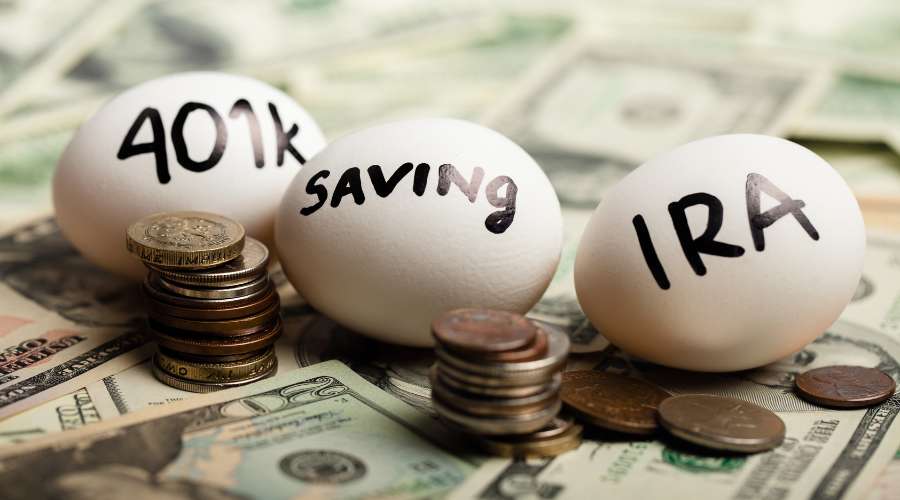
So, how does a precious metal IRA work? Gold and other precious metals are popular investments among a wide range of people. Gold is often believed to be a haven investment due to its historically low volatility and ability to protect against inflation.
Individuals who start saving early for retirement might take advantage of tax breaks by opening an Individual Retirement Account (IRA). To take advantage of the tax benefits associated with owning precious metals like gold, many people set up a self-directed IRA.
What Does it Mean to Have a Gold IRA?
Individual Retirement Accounts (IRAs) that hold gold are known as “gold IRAs.” They are a popular way to protect one’s money against inflation and spread them around. Such accounts, like traditional IRAs, provide great tax advantages.
As a substitute investment, physical gold cannot be held in a traditional IRA. Yet, as a subset of self-directed IRAs, gold IRAs are permitted to contain non-traditional assets as soon as they comply with IRS regulations.
Government laws specify the permitted storage and purity of gold kept in IRAs. These criteria can be easily accomplished by working with a gold IRA company to include precious metals in your retirement funds.
Gold Individual Retirement Accounts
Investors may choose from various IRAs, each with its benefits. One can be more practical than the other from a monetary standpoint.
Notably, a frequent kind of gold IRA is the traditional IRA. You may reduce your taxable income by the amount you donate to your conventional IRA. Contributions to this account type qualify for an immediate tax deduction. All your money from your traditional IRA will be subject to income tax.
Simply put, a Roth gold IRA is the antithesis of a standard IRA. Gold Roth IRA contributions are subject to taxation. Once the money is put into the account, growth is not taxed. When you cash out, you won’t be hit with any tax penalties. Contributions to a Roth IRA may be withdrawn at any time, unlike traditional IRAs.
Gold SEP IRA: A retirement plan option for sole proprietors and other owners of small enterprises. They are relatively similar to standard gold IRAs in terms of how they work, with the exception that company owners may put money into them for both themselves and their staff.
How Can I Put Money Into a Gold IRA?
The next step after establishing a gold IRA is making contributions. Your account may be funded in several different ways.
The most straightforward method of funding a gold IRA is via monetary contributions made straight to the account. You may buy silver along with other precious metals using the funds stored in your IRA.
Complete the necessary papers to move your existing IRA assets (gold, cash, or stocks) to the newly created gold IRA. When the assets have arrived, you may sell them and use the proceeds to buy gold or silver.
Your 401(k) or other qualified retirement plan assets may be rolled over into a gold IRA, where they can be invested in precious metals.
Some of you can’t deposit coins or bullion into your gold IRA even though you’re establishing one. The government’s restrictions on the currency that may be bought are a contributing factor.
This implies you can only put money from your gold IRA into your retirement account to buy gold or silver. Gold IRA holdings are likewise only available for withdrawal once you reach retirement age. The metals have to be kept in a secure location.
In a Precious Metals IRA, Can I Store any Metal?
Holdings in a gold IRA are not limited to gold alone. Gold Individual Retirement Accounts (IRAs) allow for the acquisition and storage of four different precious metals:
- Gold
- Silver
- Platinum
- Palladium
Owners with gold IRAs are restricted in the coins and bullion they may own by the Internal Revenue Service. These limitations are set to encourage investors to purchase precious metals of the highest grade and long-term worth.
Gold IRAs, for instance, are restricted to storing only 99.5% pure gold in the following forms:
- Coins of the American Buffalo
- Silver Pandas from China
- Credit Suisse bullion forged at a certified foundry
The American Eagle coin is the only exception. These coins have a purity of 91.67 percent, making them eligible for precious metals IRAs.
Silver bullion must meet a purity standard of 99.9%. All platinum and palladium bullion must meet a purity standard of 99.95%.
If you have questions about whether or not a particular coin, bar, or other type of bullion meets the criteria for holding in a gold IRA, you may ask your gold IRA operator.
In What Location are the Precious Metals Kept?
The safety of your silver, along with the other precious metals in your gold IRA, is an essential factor to think about. Gold IRA laws forbid holders from owning the asset; thus, storing physical gold in a house safe is out of the question.
Select a depository instead to keep your gold in. There are companies dedicated to ensuring the security of your metals.
Precious metals may be kept in one of two main storage methods.
The precious metals will be kept in a secure facility, apart from the coins & bars of other clients, if you choose for segregated storage. The metal you hold in a depository is yours to keep, and it’s identical to the metal you’ll receive when you sell it back to the storage.
The depository will keep your metals along with the metals of other clients, a practice known as “commingled storage.” The repository keeps track of the metal type, grade, and quantity contributed by each user. When you sell scrap metal, you may or may not get back the identical coins or bars that you put in. The metal of equal value will be substituted.
Both storage methods are equally safe; your decision should be based on personal preference. Bear in mind that storage costs money and that storing things separately requires more physical room and is thus more expensive.
When deciding where you’ll store your precious metals, you should also think about the safety of the vault, the level of coverage, and the storage fees.
When is the Best Time to Cash out my Gold IRA?
Investing for retirement is the IRA’s primary purpose. The United States government offers tax breaks to anyone who sets aside funds in an IRA for retirement. It also limits your freedom of action concerning your gold IRA money.
Before reaching 59 1/2, distributions from a conventional IRA must be postponed. Every withdrawal is considered income and subject to taxation once you attain retirement age. A 10% penalty will be applied to the amount of your departure if you cash out before you reach 59 1/2.
Distributions must begin once the account holder reaches the age of 70 and 1/2. Individual Retirement Account (IRA) regulations penalize those not taking required minimum distributions (RMDs) from their accounts annually.
Contributions to a Roth IRA are tax-free and may be withdrawn whenever you choose. After reaching 59 1/2, you will have unrestricted access to your contributions and profits. In any instance, withdrawals are tax-free. Early withdrawals are subject to income tax and a 10% penalty.
These generalizations are subject to a few caveats. Withdrawals made for an initial home sale, eligible medical costs, eligible tuition, or an early retirement substantially equal monthly payment plan qualify for the penalty-free premature withdrawal window.
Looking Out for Scams
As inflation rises, demand for gold and other precious metals increases. That brings us to the unfortunate reality that con artists would attempt to take pleasure in unsuspecting investors.
According to the Commodity Futures Trading Commission, these behaviors may indicate you’re dealing with a precious metals scam:
- Large yields on precious metals are often advertised in unsolicited phone calls, internet marketing, and broadcast media.
- Pressure-filled sales speeches that mention a big name or make it seem like other intelligent investors have already put up money.
- Investments for which just a fraction of their reported value is required as payment under the terms of a financing arrangement.
- Agreements without necessary details, such as the name of the financial institution involved or the location of the actual metal.
The most important thing is that the corporation or representative describes the investment in words you can grasp. When they can’t, it’s time to cut your losses and go.
In our Augusta Precious Metals scam article, we covered many topics revolving around them, including their reviews online, history, staff, and more. Augusta Precious Metals is a company that offers Gold and Silver IRAs to investors looking to roll over or start a new IRA account.

